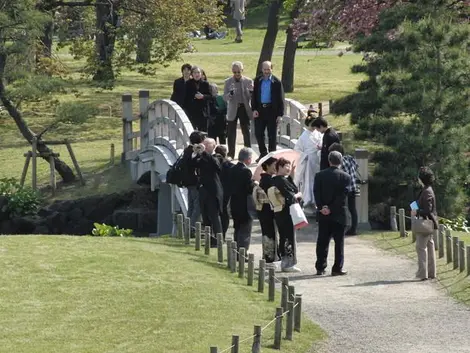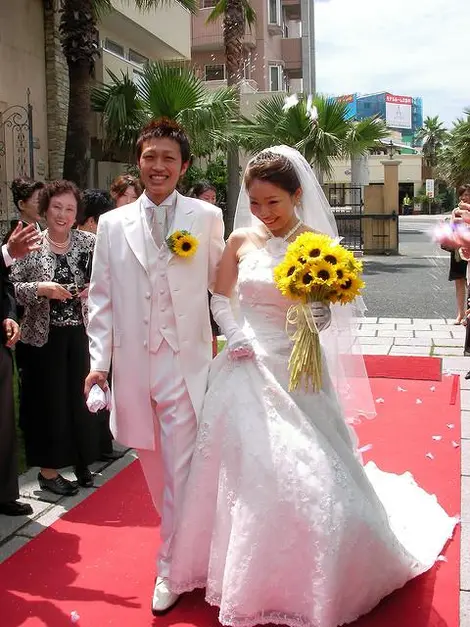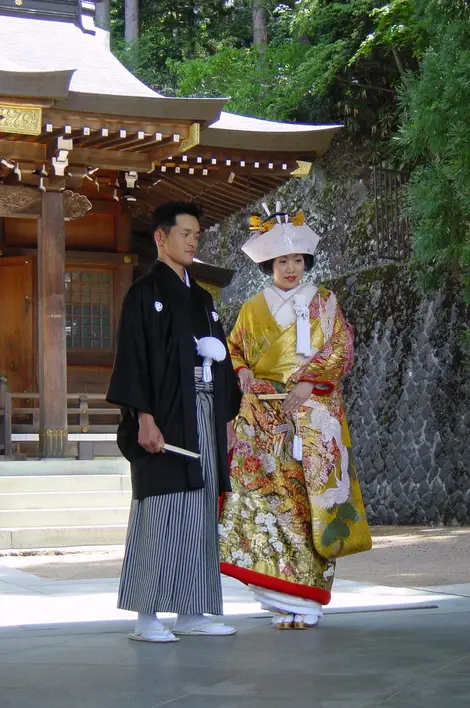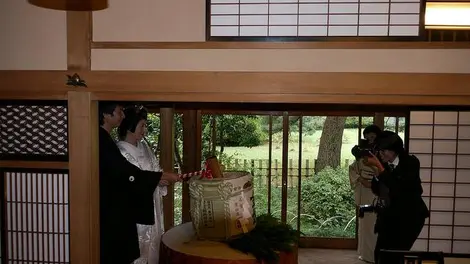Marriage in Japan 結婚
- Published on : 13/05/2016
- by : J.L.
- Youtube
Long live the newlyweds!
Marriage has become a real industry in Japan - choose between a traditional Japanese marriage or a western-style marriage!
Marriage is an important institution in Japan, and births occurring outside of wedlock represent only 2% of the Japanese population. So marriage is evidently popular, or at least rooted in morals.
To get married in Japan (between two Japanese nationals) men must be at least 18 years old and women 16 years old. However, surveys show that marriage now occurs on average at age 30 in men, and age 29 in women. This age has risen significantly in recent decades.
To be married in the eyes of the law, you simply have to file a report at the town hall. Two witnesses and an official seal on the document suffice as confirmation. Then the newlyweds are recorded on the koseki, the Japanese register of civil status.
In general women take their husband's name, because the law does not allow couples to have different names while being married.
Types of wedding
Before the wedding, there was once a traditional engagement ceremony or yuino that was carried out to unite the two families. The marriage took place at the family home of the husband. Today, this ceremony is not really practiced.
Japanese wedding ceremonies have changed a lot between the restoration of the Empire in 1868 and today. Here are some of the main changes:
In 1892, the butsuzenshiki appeared. This was a Buddhist wedding ceremony officiated by a monk, that takes place in the family temple. It was fashionable for a few years, and then disappeared almost completely, replaced by the shinto wedding. It is rare today to attend a butsuzenshiki wedding.
In 1900, the shinzenshiki, the traditional Shinto wedding ceremony, became popular. When the future Emperor Taisho Tenno got married at a Shinto temple, everyone wanted to imitate him and a trend began. During this traditional ceremony the husband carries a haorihakama, a two-piece ceremonial kimono, a white bridal kimono or shiromuku, a symbol of innocence, and a wataboshi, which is a large white silk cap for hiding his face before the end of the ceremony.
After the second world war the kyokaishiki started to gain popularity. This marks the beginning of western-style marriage becoming fashionable in Japan, and today too these ceremonies often occur in a chapel, with the bride in a classic white dress - and a white suit for the groom, too.
With jinzenshiki or hitomaeshiki marriage ceremonies, the ceremonies are not religious. The couple swear loyalty to their families and close friends over a restaurant meal, in a wedding hall, or in a hotel or garden.
Today some couples don't even celebrate their marriage in Japan, and instead go abroad for an more intimate ceremony and honeymoon.
To meet the demands of modern couples, there are now many specialist agencies that plan weddings and provide support. Often these companies have a Western-style chapel or a Shinto wedding hall that they make available for the ceremony, and a large banquet hall for the after-party. Everything is attached to a luxury hotel to accommodate all the guests.
They sell comprehensive services ranging from rental of the wedding dress (almost never bought in Japan) to a photographer: the bill can be very high due to service charges applied by the agencies.
In short, it's a real business, and that is why some couples today are choosing more and more to shorten and simplify these ceremonies, avoiding the astronomical expenses, to start a new life more simply.
Run like clockwork
Japanese marriages rarely happen like they do in Europe or the US, where they can last all day or late into the evening. In Japan, in the buildings dedicated to these ceremonies, up to two weddings per day are organized, one in the morning (from 10am) and another in the afternoon, set to finish early evening.
All the ceremonies are conducted in much the same way, thanks to the master or mistress of ceremonies who the families rely on to ensure everything goes smoothly. Stopwatch in hand, they call in order, one by one, the guests who are scheduled to make speeches at the marriages being held.
At the end, it's time to collect the envelopes of money brought by the guests for the newlyweds. It may seem impersonal just giving money, but in fact, other types of gifts are often not allowed.





















